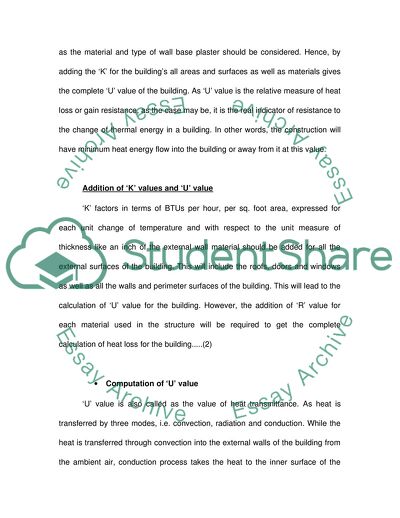
- Home
- Free Samples
- Premium Essays
- Editing Services
- Extra Tools
- Essay Writing Help
- About Us
- Studentshare
- Subjects
- Miscellaneous
- Construction technology
Construction technology - Essay Example

- Subject: Miscellaneous
- Type: Essay
- Level: Undergraduate
- Pages: 4 (1000 words)
- Downloads: 0
- Author: handbilly
Extract of sample "Construction technology"
While these indicators will determine the design of heating or cooling parameters of the building, ‘K’ value calculations, also indicate the heat loss rate, temperature difference by using a specific material. Its surface area and thickness also is considered for the total heat loss calculations.However, other parameters are responsible for the total heat loss or gain in the building. Therefore, to calculate the overall change in the thermal values, a combination of all such values for the insulation part of the external wall as well as the material and type of wall base plaster should be considered.
Hence, by adding the ‘K’ for the building’s all areas and surfaces as well as materials gives the complete ‘U’ value of the building. As ‘U’ value is the relative measure of heat loss or gain resistance, as the case may be, it is the real indicator of resistance to the change of thermal energy in a building. In other words, the construction will have minimum heat energy flow into the building or away from it at this value.‘K’ factors in terms of BTUs per hour, per sq.
foot area, expressed for each unit change of temperature and with respect to the unit measure of thickness like an inch of the external wall material should be added for all the external surfaces of the building. This will include the roofs, doors and windows as well as all the walls and perimeter surfaces of the building. This will lead to the calculation of ‘U’ value for the building. However, the addition of ‘R’ value for each material used in the structure will be required to get the complete calculation of heat loss for the building.
‘U’ value is also called as the value of heat transmittance. As heat is transferred by three modes, i.e. convection, radiation and conduction. While the heat is transferred through convection into the external walls of the building.
...Download file to see next pages Read MoreCHECK THESE SAMPLES OF Construction technology
Building construction technology
Construction Technology and Innovation
Construction Technology and Innovation
Construction Technology and Innovation
Construction Technology and Innovation
Different Areas of Construction Technology
Construction Technology: Buncefield Accident

- TERMS & CONDITIONS
- PRIVACY POLICY
- COOKIES POLICY